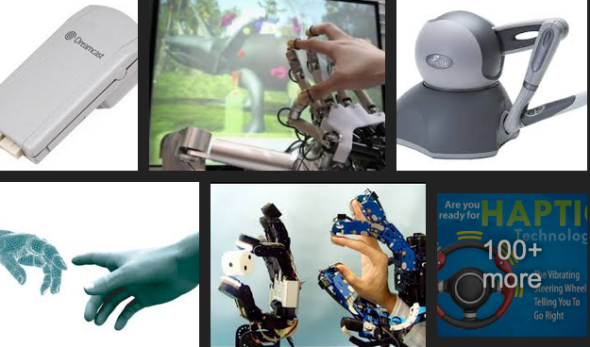haptics

Haptic technology, or haptics, is a tactile feedback technology which takes advantage of the sense of touch by applying forces, vibrations, or motions to the user. This mechanical stimulation can be used to assist in the creation of virtual objects in a computer simulation, to control such virtual objects, and to enhance the remote control of machines and devices (telerobotics). It has been described as “doing for the sense of touch what computer graphics does for vision”. Haptic devices may incorporate tactile sensors that measure forces exerted by the user on the interface.
Haptic technology has made it possible to investigate how the human sense of touch works by allowing the creation of carefully controlled haptic virtual objects. These objects are used to systematically probe human haptic capabilities, which would otherwise be difficult to achieve. These research tools contribute to the understanding of how touch and its underlying brain functions work.
The word haptic, from the Greek ἅπτικός (haptikos), means pertaining to the sense of touch and comes from the Greek verb ἅπτεσθαι haptesthai, meaning to contact or to touch.
via
__________________
Pattie Maes ness
__________________
________________
from Jaron Lanier‘s dawn of new everything
123
too early to work w proper 3-d graphics.. we could dive into haptics: broadly means sensations that come form either sensor cells in the skin or in muscles or tendons – generally meaning sensations reports thru the spinal cord instead of a dedicated nerve bundle between a sense organ and the brain. it is impossible to separate such sensations from human motion, so haptics isn’t just about sensing. haptics includes touch and feel and how the body senses its own shape and motion, and the resistance of obstacles.. it’s surprisingly hard to define the term precisely because there are still mysteries about how the body senses itself and the world.. (derived from greek haptikos, meaning ‘able to come into contact’)..
124
haptics at very least how you feel that a surface is hot, rough, pliant, sharp, or shaking – and how you sense stubbing a toe or lifting a weight. it’s a kiss, a cat on a lap, smooth sheets, and corduroy desert roads..it is the pleasure of the sex that made us all and the pains of the diseases that end us. it is the business end of violence.
it’s the sense that overlaps the most with the other sense.
i love the haptic modality in part because we still haven’t learned to work w it well or fully appreciate it. it’s an intimate frontier..
we tend to use visual metaphors to convey analytic mastery, seeing a situation clearly, while haptic metaphors tend to convey intuition, gut feelings.. haptics is about you as a part of the world, not as an observer..
other senses are aloof compared w haptics.. they eyes and ears are interactive, in the sense that they probe by subtly and subconsciously shifting their positions.. but haptics require direct contact w the world.. you push against things to feel them.. you change them at least a little in order to perceive them.
every touch carves away at least a saving of what is touched..faint gouges are being carved in the glass where you touch your phone the most. you are the weather of your world slowly wearing it down.. that is the price of sensations…
125
funny how moore’s law forced us to build useful equipment for each of the sensory modalities in a sequence instead of all at once; haptics first, then hearing, then vision, w olfaction, taste and debatable catalog of other senses still to come. funny, because it mirrored the way i was slowly becoming more able to perceive the world as i emerged from the trauma of my mother’s death
a bridge between the way nature had made the human body expressive and the digital world was finally – literally – at hand (glove)
_________________



















